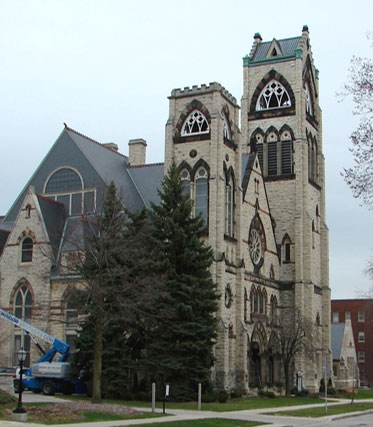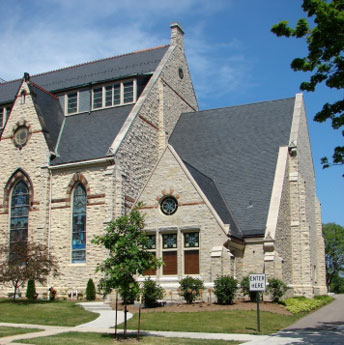28. Immanuel Presbyterian, 1873
1100 North Astor Street (between State Street and Juneau Avenue)
Architect: Edward Townsend Mix
Immanuel Presbyterian represents the continuation of the earliest Presbyterian congregation in Milwaukee. The First Presbyterian Church was founded in 1837, when Milwaukee was a small, unincorporated village. A second congregation, North Presbyterian, was established in 1849. When Presbyterians living on the west side of the Milwaukee River left to form Calvary Church in 1869, the two older congregations reunited and took the name Immanuel Presbyterian.
The congregation quickly set out to build a new house of worship and commissioned Edward Townsend Mix to prepare the plans. Construction of the church began in 1873 and was completed in December of the following year. With seating for 1,000 worshippers on the main floor and another 200 in the balcony, the new church had a capacity comparable to that of St. John’s Catholic Cathedral and was one of the largest churches in Wisconsin at the time of its completion.
Immanuel Presbyterian shows the influence of the Venetian Gothic, a variation on the nineteenth century Gothic Revival that is based on the fourteenth and fifteenth century architecture of Venice. Inspired by the publication in the early 1850s of The Stones of Venice, a three-volume treatise by the English art historian and critic John Ruskin, the style is sometimes called Ruskinian Gothic. The characteristic that immediately distinguishes the Venetian or Ruskinian Gothic from other Gothic Revival buildings is the use of strongly contrasting colors of stone or brick, and especially the use of alternating light and dark colors for voussoirs (the stones that form the arches above the doors and windows). The exterior walls of Immanuel Presbyterian are a light-colored limestone from a quarry in nearby Wauwatosa, with a smaller amount of dark reddish-brown sandstone. The three pairs of polished granite columns at the front entrance were imported from Scotland.
A devastating fire in late December of 1887 caused the roof to collapse and destroyed most of the interior and the windows, leaving little more than the stone walls intact. The church again commissioned Edward Townsend Mix to plan and supervise the reconstruction. Mix retained the stone walls with only a few minor changes to the fenestration, but planned a new roof structure for the building and extensively redesigned the interior. As originally built, two rows of columns separated the auditorium space into a tall central nave and lower side aisles, in the traditional Gothic manner. Mix devised an unusual configuration of iron trusses to support the new roof, spanning the entire width of the building and eliminating the need for interior columns. This gives the interior a lighter and more open character, and serves to emphasize the unusually grand scale of the worship space. The rebuilt church opened in the spring of 1889.
A recent addition at the south end of the church, completed in 2014, provides additional space adjacent to the chancel for a variety of uses. Although this addition was built 140 years after the original construction of the church, it achieves a remarkable degree of compatibility with the historic building in its style, materials, and details.
Sources:
“Adopted a Plan,” Milwaukee Sentinel, March 22, 1888, page 3, column 4.
“Church in Ruins,” Milwaukee Sentinel, December 31, 1887, page 1, column 5.
“City of Churches,” Milwaukee Sentinel, May 13, 1888, page 11, column 6.
Grellinger and Rose, architects. Drawings for renovations to Immanuel Presbyterian Church dated 1957 and 1858. Wisconsin Architectural Archive, Milwaukee Central Library, drawing set 163-30.
Gurda, John. Keeping Faith in the City: A History of Immanuel Presbyterian Church. Immanuel Presbyterian Church, c. 1987.
“Immanuel Presbyterian Church 90 Years Old,” Milwaukee Sentinel, April 9, 1927, page 18, column 2.
Pagel, Mary Ellen. “Immanuel Presbyterian Church.” Historical Messenger of the Milwaukee County Historical Society, September 1965, pages 82-95.
“Rebuilding Immanuel Church,” Milwaukee Sentinel, January 19, 1888, page 3, column 2.
Scott, Fitzhugh, architect. Drawings for renovations to Immanuel Presbyterian Church, dated September 20, 1937. Wisconsin Architectural Archive, Milwaukee Central Library, drawing set 32-280.
Szczesny-Adams, Christy M. Cosmopolitan Design in the Upper Midwest: the Nineteenth Century Architecture of Edward Townsend Mix. Ph. D. Dissertation, University of Virginia, 2007.
“Will Soon be Completed,” Milwaukee Sentinel, October 8, 1888, page 3, column 1.



